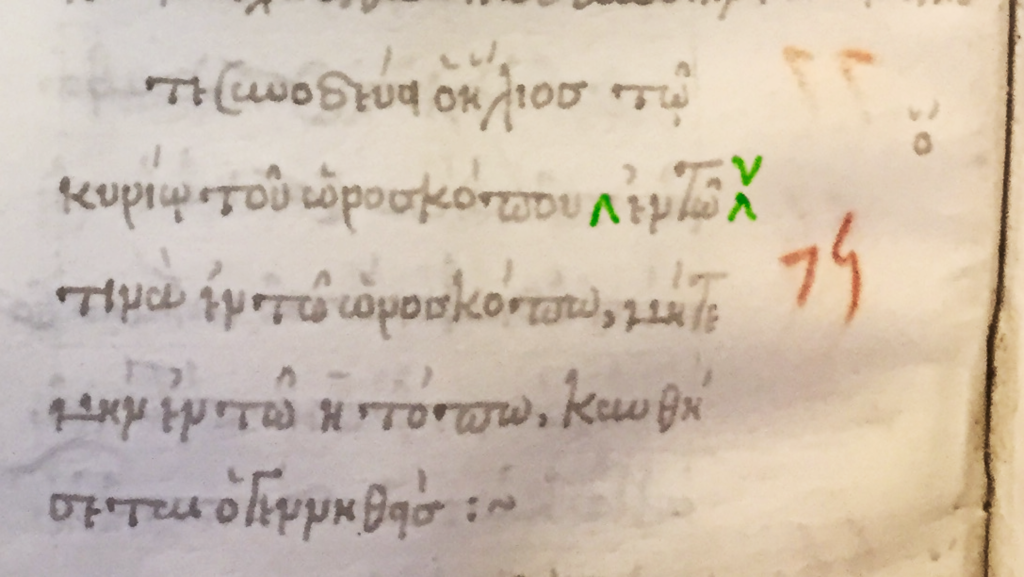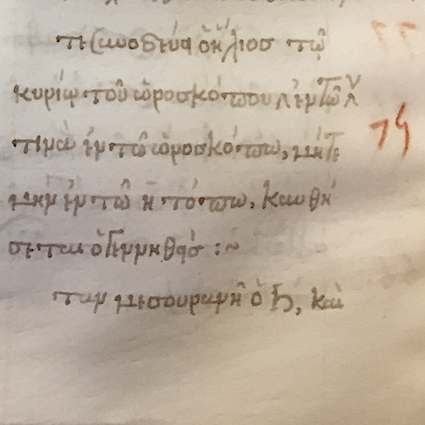Critical editions are incredibly handy. They transform historical artifacts into an easily read, generic version of some text. They smooth out differences between versions, they correct grammar, and they normalize orthography. The labors of intrepid and tireless editors save us untold time and energy.[1] But those same labors, those efforts to efface differences and to normalize texts, and our inclination to rely on critical editions bring various consequences. Not least of which is, when reading a critical edition we too readily forget just how heterogeneous and variable premodern texts were. By relegating the heterogeneity of premodern texts to footnotes — which many people will not read and some (many?) of those who do read them will not entirely understand — we make it too easy to assume that the past was neater and more coherent than it was.
An example of the messiness of the premodern text is aphorism 75 from Ptolemy’s Ὁ Καρπός. The critical edition has:
Ὅτε συνοδεύει ὁ Ἄρης τῷ κυρίῳ τοῦ ὡροσκόπου ἐν τῷ Λέοντι καὶ μὴ ἔχῃ ὁ Ἄρης οἰκοδεσποτίαν τινὰ ἐν τῷ ὡροσκόπῳ μήτε μὴν ἐν τῷ ὀγδόῳ τόπῳ, καυθήσεται ὁ γεννηθείς. [When Mars conjoins with the ruler of the ascendent in Leo, and Mars does not have any rulership on the ascendent nor in the eighth house, the native will be burnt.]
A footnote indicates that some versions substitute “ἥλιος” for the first instance of “ἄρης,” as well as a couple other variations. But surveying copies is a lot more interesting to see just how different the versions can be, and allows us to ask other questions that might get lost in the footnote of the critical edition.
Compare two 14th-century copies, both from the Laurenziana in Florence:

BML Plut. 28.16:
Ὅτε συνοδεύει ὁ «ἥλιος» τῶ κυρίω τοῦ «ὡροσκόπου» ἐν τῶ [blank] καὶ μὴ ἔχη ὁ «Ἄρης» οἰκοδεσπότην τινὰ ἐν τῶ «ὡροσκόπῳ» μήτε μὴν ἐν τῶ ηʹ τόπω, καυθήσεται ὁ γεννηθείς.

BML Plut. 28.20:
Ὅτε συνοδεύει ὁ «Ἄρης» τῶ κυρίω τοῦ «ὡροσκόπου» ἐν τῶ «Λέοντι» καὶ μὴ ἔχη ὁ «Ἄρης» οἰκοδεσποτίαν τινὰ ἐν τῶ «ὡροσκόπῳ» μήτε μὴν ἐν τῶ ὀγδόω τόπω, καυθήσεται ὁ γεννηθείς.
There is no evidence that anybody who read these two manuscripts sensed any problem. Not even in the copy where the sign, Λέοντι, is missing, has any reader left evidence of noticing a problem.
Two copies in Vienna have been in the imperial library since the brilliant Hungarian humanist Johannes Sambucus established the library in the mid-sixteenth century. One of the copies was from Sambucus’s own collection while the other one was added to the library in the first years, while Sambucus was the imperial librarian. Again we see some interesting variation:

ÖNB Cod. Phil. gr. 37:
Ὅτε συνοδεύει ὁ «Ἄρης» τῶ κυρίω τοῦ ὡροσκόπου ἐν τῶ «Λέοντι» καὶ μὴ ἔχη ὁ «Ἄρης» οἰκοδεσποτίαν τινὰ ἐν τῶ ὡροσκόπω μήτε μὴν ἐν τῶ ηʹ τόπω, καυθήσεται ὁ γεννηθείς.

ÖNB Cod. Med. gr. 49:
[Ὅ]τε συνοδεύει ὁ ἥλιος τῷ κυρίῳ τοῦ ὡροσκόπου ^ ἐν τῶ ^ τινὰ ἐν τῶ ὡροσκόπω, μήτε μὴν ἐν τῶ ηʹ τόπω, καυθήσεται ὁ γεννηθείς.
While Sambucus surely had the skill and expertise to read and understand these manuscripts, there is no evidence that he or anybody else did. Nor is there any evidence that any body ever noticed that they differed from each other. In the case of cod. med. gr. 49, the aphorism makes little sense as written. Some reader (perhaps Sambucus himself) appears to have noticed that something was missing and inserted carets, but never added any words. So we can’t know what he did or did not sense was lacking.
In other instances, the copiest or some other reader marked possible variations. For example, in a 15th-century copy a reader added an interlinear symbol for ἄρης above the symbol for ἥλιος, perhaps to correct his copy although he might merely have been indicating that both symbols were found in different copies:

BnF Coislin 338:
Ὅτε συνοδεύει ὁ « Ἄρης/ἥλιος» τῶ κυρίω τοῦ «ὡροσκόπου» ἐν τῶ [blank] καὶ μὴ ἔχει ὁ «Ἄρης» οἰκοδεσπότην τινὰ ἐν τῶ «ὡροσκόπῳ» μήτε μὴν ἐν τῶ ηʹ τόπω, καυθήσεται ὁ γεννηθείς.
The reader did not seem as bothered by the long line where in other copies we read Λέοντι.

One final copy, Vat. Barb. gr. 1, gives us yet another version of the text. This 17th-century copy includes commentary for many of the aphorisms. For aphorism 75 we read:
Ὅτε συνοδεύει ὁ «Ἄρης» τῶ κυρίω τοῦ ὡροσκόπου ἐν τῶ λέοντι καὶ μὴ ἔχει ὁ «Ἄρης» οἰκοδεσπότην τινὰ ἐν τῷ ὡροσκόπω μήτε μὴν ἐν τῶ ηʹ τόπω, καυθήσεται ὁ γεννηθείς.
The copiest then added in the commentary below the aphorism: “*ὁ «Ἄρης» alii ὁ «ἥλιος».” Whereas in other copies, e.g., Coislin 338, only the initial Ἄρης was replaced by ἥλιος, the scribe noted that both instances of Ἄρης are sometimes replaced by ἥλιος.
By taming this pre-modern chaos the critical edition closes off all sorts of questions. Moreover, the critical edition does not (and perhaps can’t) capture the richness of pre-modern texts and knowledge. And, as Anthony Grafton pointed out a number of years ago as he tried to trace the sources for Scaliger’s chronology, if we want to understand pre-modern scholars and how they constructed their systems of knowledge, we need to read the versions of the texts they encountered, not the versions very learned and extremely diligent editors have produced for us.[2]
- These editions do not, however, save us much money. They tend to be published by presses that charge a small fortune for each volume. No doubt, the price is related to a business model that assumes libraries and archives are the primary market, and that they will purchase scholarly/critical editions regardless of the price. A couple questions come to mind: First, as an editor is it sufficiently rewarding to know that after all your work your edition gathers dust on shelves in a hundred or so libraries around the world? Is the value of your labor merely the existence of the book that contains the edition you produced? Second, given the shrinking library budgets and growing material costs, how much longer can this model last? When will the handful of presses that still print editions simply stop because it’s no longer financially defensible? ↩
- See Anthony Grafton, “Editing Technical Neo-Latin Texts: Two Cases and Their Implications” in Editing Greek and Latin Texts (1987), 163–186. ↩
